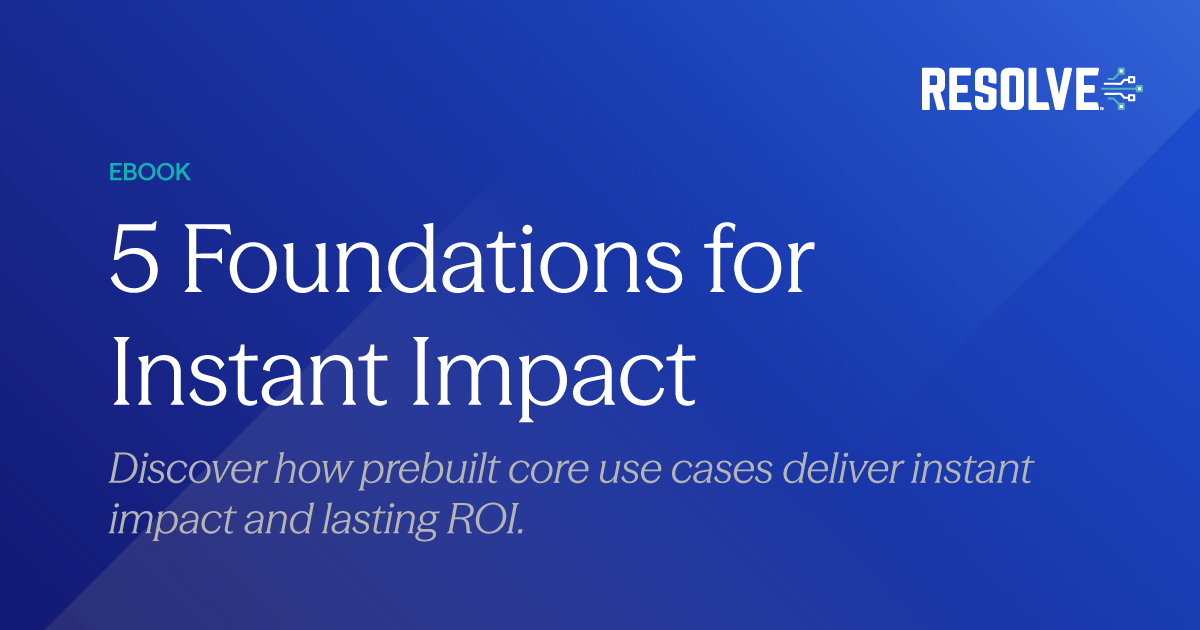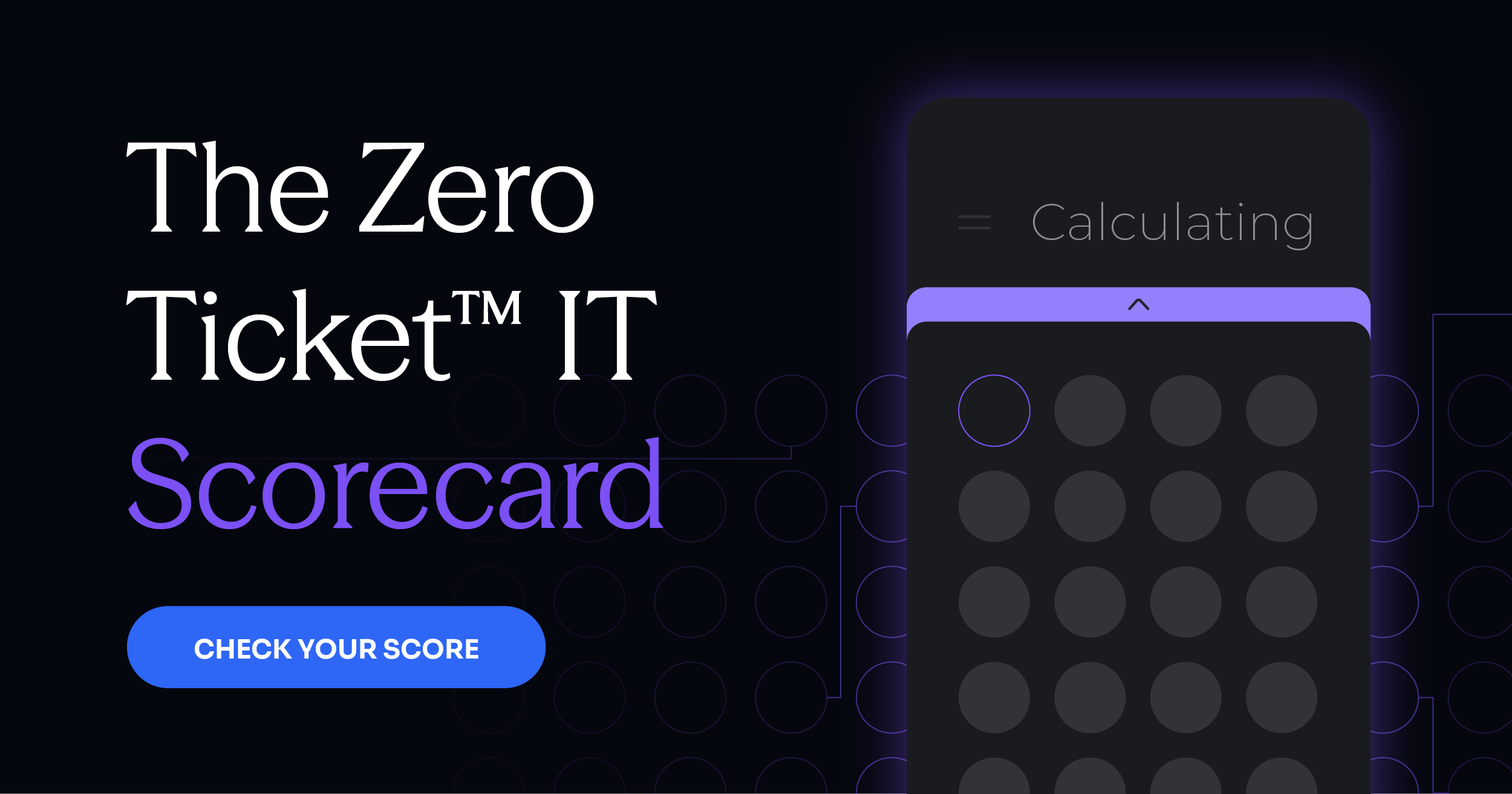
Zero Ticket IT Process Automation: Beyond the Service Desk
Subscribe to receive the latest content and invites to your inbox.
Traditional IT process automation has always promised faster, more efficient operations. But for years, it’s been largely synonymous with service desk workflows: password resets, access requests, and the like. Those are important, no doubt. But limiting automation to the service desk is like only automating the assembly line in a factory while leaving the rest of the production floor manual.
At Resolve, we believe IT process automation should span the full stack: infrastructure, networks, incident response, release cycles, and even security operations. This expanded vision is at the core of what we call Zero Ticket IT: a future where AI-powered agents like RITA, our tier-0 ticket deflector, and Jarvis, our no-code workflow builder, autonomously resolve issues, prevent incidents, and eliminate operational bottlenecks.
In this blog, we’ll explore five key areas where IT process automation goes beyond the service desk and how Resolve’s agentic AI is already helping enterprise IT teams bring this vision to life.
1. Infrastructure Automation: Zero-Touch Operations at Scale
Modern IT infrastructure is dynamic, distributed, and deeply complex. Managing servers, VMs, cloud assets, and storage systems across hybrid environments requires speed, consistency, and context—exactly what agentic IT process automation provides.
With Resolve’s automation platform, AI agents:
- Automatically provision cloud or on-prem resources based on policy triggers
- Monitor infrastructure health and proactively remediate issues
- Reboot servers, reallocate memory, or restart services without human intervention
Instead of waiting for manual tasks to clog queues, Resolve agents act as intelligent monitors and first responders, fixing routine infra issues in seconds and escalating only when necessary.
The result? Reduced downtime, faster performance, and a significant drop in repetitive tickets tied to underlying infrastructure.
2. Network Operations: From Alert Storms to Autonomous Resolution
IT networks are the backbone of business continuity and one of the most complex areas to manage manually. From bandwidth issues to routing conflicts and access control, network operations teams risk being constantly swamped in noisy alerts and redundant tasks.
Resolve brings agentic AI into NetOps with:
- Intelligent alert suppression and correlation
- Automated responses to high-volume events (e.g., interface flaps, threshold breaches)
- Configuration drift detection and resolution
- Autonomous switch/router updates based on policy triggers
Our AI agents don’t just push config files; they understand context, operate within guardrails, and take predefined actions based on best practices and real-time telemetry.
This level of intelligent network automation slashes MTTR, minimizes human error, and ensures that only high-value issues reach human operators, freeing them up to focus on proactive network optimization.
READ MORE: Network Automation Guide for IT Operations
3. Incident Response: Accelerating MTTR with Intelligent Agents
Every second counts during an incident. But traditional incident response workflows often suffer from delays caused by manual triage, incomplete context, and fragmented tools.
With Resolve’s agentic IT process automation, you get:
- End-to-end incident triage based on real-time data ingestion
- Automated root cause analysis and correlation across logs, metrics, and events
- Workflow triggers that can instantly isolate, resolve, or rollback configurations
- Bidirectional integrations with your ITSM, monitoring, and observability stack
Instead of relying on static runbooks or siloed alerts, Resolve’s AI agents orchestrate dynamic, cross-domain responses to incidents as they unfold, fixing them automatically or escalating with all the context your human operators need.
Organizations using Resolve see dramatic reductions in incident resolution time, SLA breaches, and support escalations. That’s the power of Zero Ticket IT in high-pressure scenarios.
READ MORE: Why Generative AI Isn’t Enough: You Need Agents, Not Just Answers
4. Release and Patch Management: Consistency Without the Chaos
Keeping software and systems updated is a mission-critical—and potentially painful—process. Without automation, patching and release workflows are prone to delays, errors, and inconsistent deployment across environments.
Resolve’s approach to automated patch and release management includes:
- Automated detection of outdated packages and dependencies
- Orchestrated patching across servers and applications
- Smart scheduling and contextual safeguard rollbacks to minimize disruption
- Compliance verification and audit reporting without manual checklists
Our AI agents ensure that patches and releases are applied consistently and intelligently, across environments and time zones, without waiting for tickets or approvals to delay security posture or app performance.
By automating this often-overlooked category of IT process automation, enterprises can reduce exposure to vulnerabilities, enforce governance, and keep systems aligned with compliance standards all while minimizing manual lift.
5. Site Reliability Engineering: Automating Resilience at the Core
Site reliability engineering (SRE) isn’t just about keeping systems up—it’s about building a foundation where uptime, performance, and efficiency are engineered into every layer of operations. But as systems scale and complexity compounds, manual toil remains a major barrier to SRE success.
Resolve empowers SRE teams with intelligent automation that reduces toil and strengthens reliability practices by:
- Detecting SLO breaches and triggering remediation workflows in real time
- Automating runbook execution for common reliability scenarios like failover, cache clearing, and circuit breaking
- Coordinating chaos test preparation and controlled rollback plans
- Enabling continuous improvement by turning learnings into automation templates
Instead of chasing incidents or scripting one-off solutions, SREs can codify best practices into autonomous workflows, ensuring consistency, speed, and resilience across every environment.
By embedding automation directly into reliability engineering practices, Resolve helps teams minimize manual intervention, scale proven patterns, and reinforce the reliability goals that keep modern enterprises competitive and always-on.
Zero Ticket IT Is the Next Evolution of IT Process Automation
The takeaway is clear: the old model of IT process automation (limited to service desk scripts and siloed workflows) no longer meets the demands of modern enterprise operations. Today, real automation means deploying intelligent agents, like RITA and Jarvis, that work across the entire IT ecosystem, not just where the tickets start.
Resolve’s agentic AI platform is built for this reality. It powers Zero Ticket IT by:
- Intercepting and resolving issues autonomously
- Preventing incidents before they happen
- Connecting processes across infrastructure, cloud, security, and beyond
- Enabling non-technical teams to build and scale automation without coding
As organizations seek to reduce cost, improve reliability, and accelerate transformation, intelligent IT process automation becomes not just a nice-to-have, but a competitive imperative.
The future of IT isn’t about faster tickets. It’s about no tickets. And that future is already being realized by enterprises embracing Resolve’s agentic AI.
Ready to take your IT process automation beyond the service desk and toward the Zero Ticket vision?
→ Request a Demo






